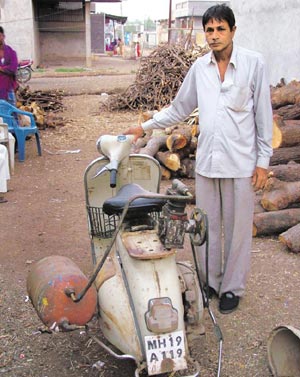Mumbai: As India prepares to launch itself into a new decade of economic growth, the year’s top movie is energizing a rapidly expanding national network of grass-roots enterprise.
If you’ve seen 3 Idiots, a frothy film about an impoverished, smart-alecky student-inventor who lives by his wits, you can’t miss the scooter-powered flour mill, a cycle-powered horse shaver and an exercycle-cum-washing machine.

Creativitypays: A scene from the film 3 Idiots, with the scooter-powered flour mill, which was sourced from NIF, in the background.
Creativitypays: A scene from the film 3 Idiots, with the scooter-powered flour mill, which was sourced from NIF, in the background.
The film 3 Idiots is topping critic lists and box-office collections, prompting producer Vidhu Vinod Chopra to quietly announce a fund for the three real-life brains—a Kerala teen, a Uttar Pradesh barber and a Maharashtra painter—powering the fertile imagination of wannabe engineer “Rancho”, or Ranchoddass Shyamaldas Chanchad, Aamir Khan’s character.
The inventions were sourced from the National Innovation Foundation (NIF), set up nine years ago by the Indian government with inspiration and support from a 16-year-old proponent of grass-roots invention, the Honey Bee Network. Both NIF and Honey Bee (the name is a metaphor for the cross-pollination of ideas) figure in the credits of 3 Idiots.
The popular attention to rural invention couldn’t come at a better time for a nation that increasingly values creativity but is still given to rote learning at schools and colleges.
“We can call Mr Chopra’s contribution the Idiot-NIF fund,” joked Anil Gupta, Honey Bee’s founder and professor, Indian Institute of Management, Ahmedabad (IIMA). “I hope what Munnabhai did for Gandhigiri, this film will do for innovation in India,” he said, referring to 3 Idiots director Raju Hirani’s last movie.
NIF has 140,000 inventions from 545 districts in its database, generating 220 patent applications in India and one in the US. Over the last two years, officials and inventors have travelled to China, Indonesia and the Philippines to share their stories.

In the spotlight: Jehangir Painter with his scooter-powered flour mill. Ganesh Surse/HT
In the spotlight: Jehangir Painter with his scooter-powered flour mill. Ganesh Surse/HT
“Lots of innovations are now going to market,” said NIF’s chief innovation officer Vipin Kumar, who received a call from Chopra’s unit on Tuesday. “As many as 50 technologies have been transferred to companies, and inventors are getting royalties, some up to 5% on sales.”
The stories of the inventors whose machines feature in Chopra’s film mirror the adversity-derived chutzpah that has so endeared “Rancho” to India over the last six days:
• Remya Jose (20), a student from Kerala’s Malappuram district, created the exercycle-cum-washing-machine when her mother was ill and father had cancer. The Discovery Channel shot a video of her invention, now a YouTube hit.
• Mohammed Idris (32), a class V dropout and a barber from western Uttar Pradesh’s Meerut district, invented a cycle-powered horse clipper that pares equine hair in half the time that it takes hard-to-find electric shavers.
• Jehangir Painter (49), a painter from north Maharashtra’s Jalgaon town, put together a scooter-powered flour mill to relieve his wife from the tedium of blackout-induced three-hour waits for wheat to be ground.
When the Hindustan Times called Painter at his home 430km north of Mumbai, he had seen 3 Idiots and was waiting for the return of his scooter. “It felt great, and me and my yellow scooter are a talking point in Jalgaon,” he said.
His favourite scene? “I liked the shot where Kareena (Kapoor) walks towards Aamir beside the lake,” he said. “And my scooter is framed with them.”
The Indian ability to innovate is not new and is exemplified by the word jugaad. It has no direct English translation, but refers to the ability to engineer a solution—mechanical or otherwise—to a problem.
Jugaad has now entered mainstream lexicon as the get-it-done ability of Indian companies. It has also found its way into some business school courses.
IIMA’s Gupta is now on a week-long, 250km trek of discovery of such solutions. It is a journey he organizes twice a year so scientists and other experts can uncover talent in India’s remotest corners.
Gupta explained how he was examining a farmer’s Rs200 invention to pick weeds from a paddy field in an Assam village.
NIF is India’s national effort to move backyard inventions discovered by the Honey Bee Network beyond the jugaad stage and into mainstream business. It gets experts from the Council of Scientific and Industrial Research and the Indian Council of Medical Research (ICMR) to mentor inventors.
After such vetting, at least 140 projects over the last four years have been funded under the Micro Venture Innovation Fund, a “high-risk” fund set up by the Small Industries Development Bank of India.
Meerut’s Idris, for instance, has received Rs25,000 to explore the market for his horse-shaver.
Depending on the innovation and aptitude of the inventors, some win fellowships to national laboratories; others are routed to small and medium firms that may offer royalties, exclusive or non-exclusive marketing rights, a share in profits or simple purchase of inventions, explains Kumar.
ICMR is closely involved because more than half the discoveries flow from traditional medical knowledge.
From Arunachal Pradesh, Gupta said 3 Idiots was a “great effort to link the small ideas with the big picture” and should hopefully now symbolize the national storehouse of inventors. “They (the movie makers) have ignited the fire, now we have to channel it,” said Gupta. “It’s a great opportunity to create mass awareness.”
|

